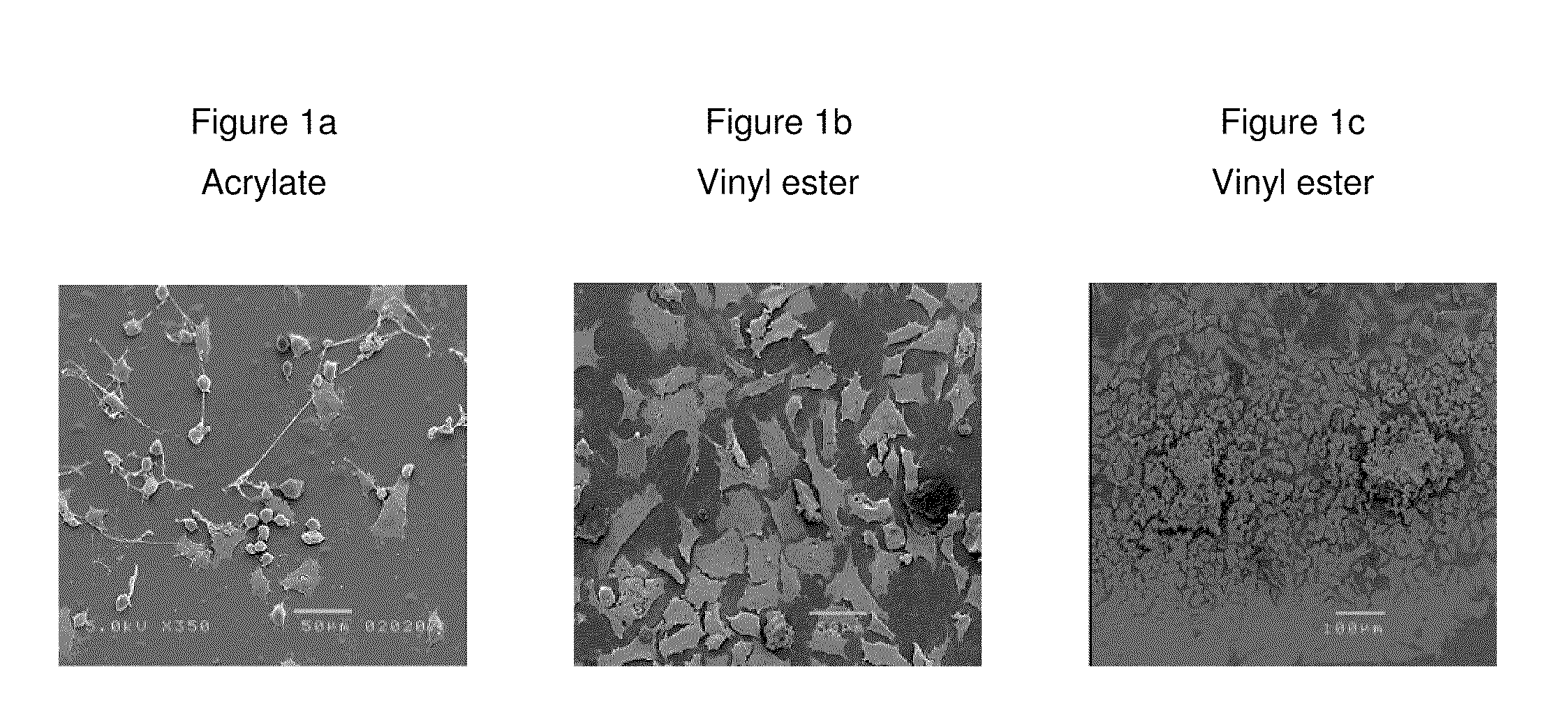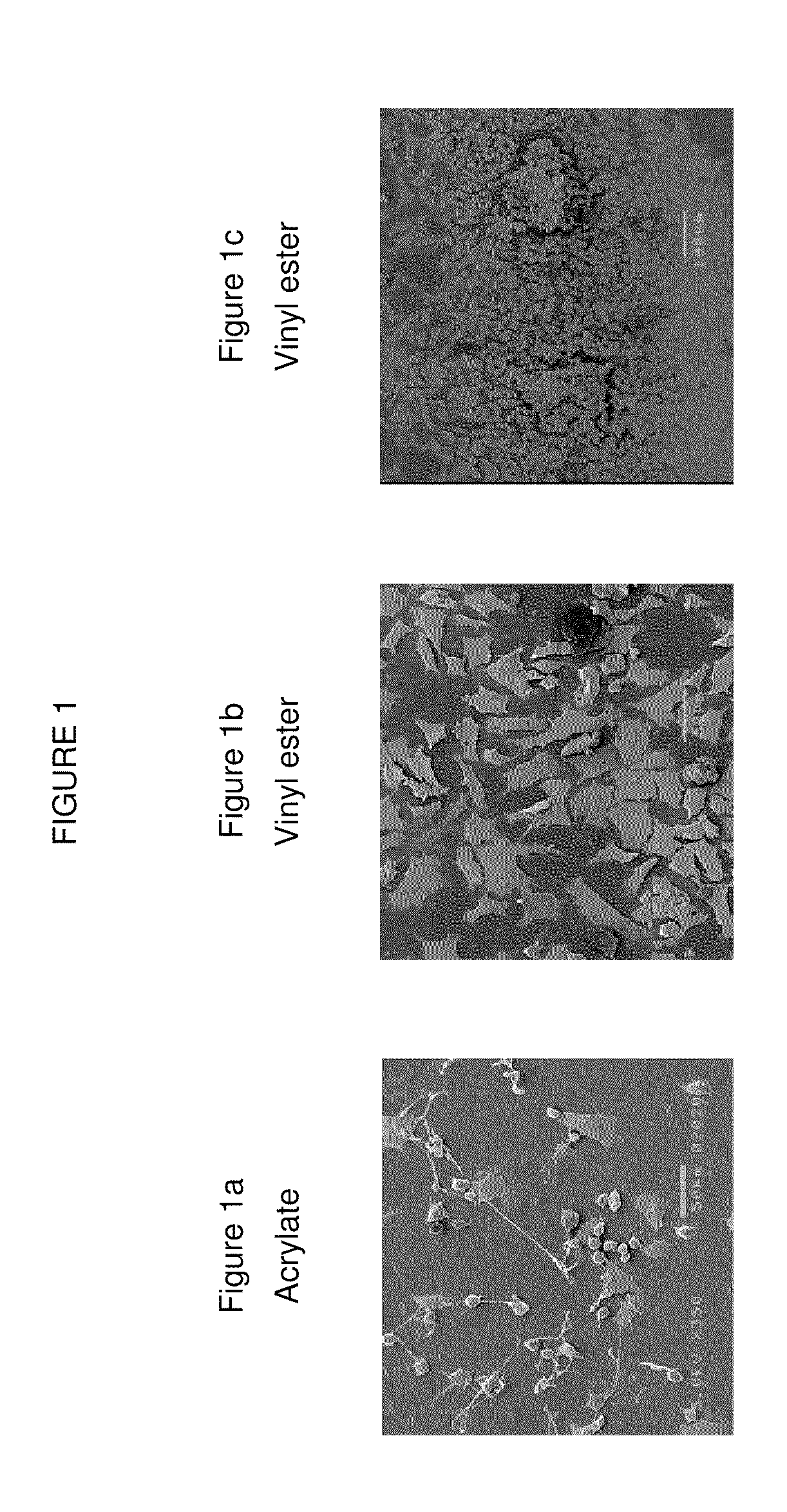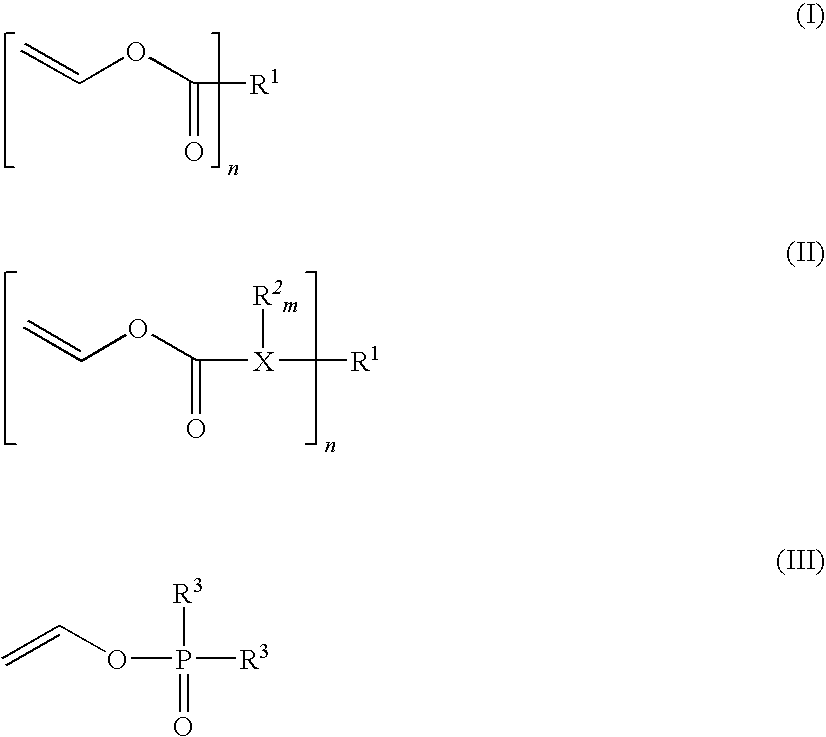Composition that can be cured by polymerisation for the production of biodegradable, biocompatible, cross-linkable polymers on the basis of polyvinyl alcohol
- Summary
- Abstract
- Description
- Claims
- Application Information
AI Technical Summary
Benefits of technology
Problems solved by technology
Method used
Image
Examples
synthesis example 1
Synthesis of sebacic acid divinyl ester (SEVE)
[0085]
[0086]15 g (74.2 mmol) of sebacic acid, 0.66 g (2.06 mmol) of mercury(II)acetate, and 0.12 g of hydroquinone were precharged in 75 ml of vinyl acetate into a 250 ml three-necked flask and stirred for 20 minutes under argon. Then, 0.09 g (0.01 mol) of p-toluenesulfonic acid were added as a catalyst, and the reaction mixture was refluxed for 4 hours. After cooling down to room temperature, the obtained solution was diluted with 200 ml ethyl acetate and extracted with 150 ml 2N NaOH. The organic phase was dried over Na2SO4, and the volatile components were removed on a rotary evaporator. Purification by flash column chromatography on silica gel (PE:EE=10:1) yielded 8.9 g (47% of th.) of a colorless liquid.
[0087]1H-NMR (CDCl3), δ (ppm): 7.25 (2H, dd, J=14.07 / 6.25 Hz, H2C═CH—); 4.84 (2H, dd, J=14.07 / 1.56 Hz, —HC═C(H)H); 4.52 (2H, dd, J=6.25 / 1.56 Hz, —HC═C(H)H); 2.35 (4H, t, —CO—CH2—); 1.62 (4H, q5, —CO—CH2—CH2—);1.29 (8H, s, —CH2—).
synthesis example 2
Synthesis of octanedioic acid divinyl ester (KVE)
[0088]
[0089]The synthesis was carried out analogously to synthesis example 1. Purification by flash column chromatography on silica gel (PE:EE=10:1) yielded 11.4 g (47% of th.) of a colorless liquid.
[0090]1H-NMR (CDCl3), δ (ppm): 7.26 (2H, dd, J=13.84 / 6.21 Hz, H2C═CH—); 4.85 (2H, dd, J=13.84 / 1.47 Hz, —HC═C(H)H); 4.54 (2H, dd, J=6.21 / 1.47 Hz, —HC═C(H)H); 2.37 (4H, t, —CO—CH2—); 1.65 (4H, q5, —CO—CH2—CH2—);1.48-1.25 (4H, m, —CH2—).
synthesis example 3
Synthesis of N-acetyl phenylalanine vinyl ester (PAVE)
[0091]
[0092]Lit.: M. I. Weinhouse, K. D. Janda, “A new methodology for the preparation of vinyl esters”, Synthesis 1, 81-83 (1993).
a) Synthesis of N-acetylphenylalanine 2-(phenylseleno)ethyl ester
[0093]In a 50 ml round bottomed flask, 2.55 g (13.3 mmol) of 1-(3-dimethylamino propyl)-3-ethyl carbodiimide hydrochloride and 1.7 g of (8.2 mmol) phenylalanine were added to a solution of 1.87 g (9.3 mmol) of 2-(phenylseleno)ethanol in 20 ml of THF. The reaction mixture was then stirred for 12 hours at room temperature. The mixture was then diluted with 50 ml of ethyl acetate and extracted with 50 ml of a 0.5 M HCl solution. The organic phase was dried over sodium sulfate, filtered, and the solvent was removed in vacuo. Purification by column chromatography (PE:EE=2:1) yielded 2.9 g (91% of th., 98% of lit.) of a yellowish liquid.
[0094]1H-NMR (CDCl3), δ (ppm): 7.3-7.1 (10H, m, Ar—H); 6.62 (1H, d, J=8.7 Hz, NH); 4.64 (1H, m, N—CH); 4.31 ...
PUM
| Property | Measurement | Unit |
|---|---|---|
| Fraction | aaaaa | aaaaa |
| Percent by mass | aaaaa | aaaaa |
| Percent by mass | aaaaa | aaaaa |
Abstract
Description
Claims
Application Information
 Login to View More
Login to View More - R&D
- Intellectual Property
- Life Sciences
- Materials
- Tech Scout
- Unparalleled Data Quality
- Higher Quality Content
- 60% Fewer Hallucinations
Browse by: Latest US Patents, China's latest patents, Technical Efficacy Thesaurus, Application Domain, Technology Topic, Popular Technical Reports.
© 2025 PatSnap. All rights reserved.Legal|Privacy policy|Modern Slavery Act Transparency Statement|Sitemap|About US| Contact US: help@patsnap.com



